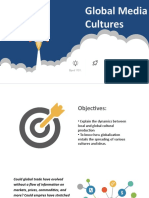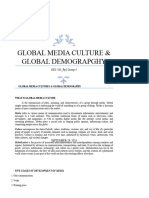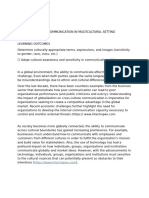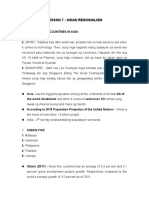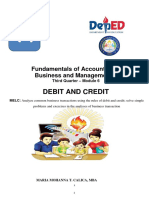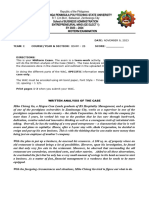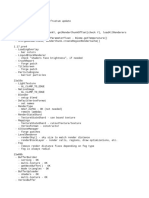Lesson 8
Lesson 8
Uploaded by
triicciaa faithCopyright:
Available Formats
Lesson 8
Lesson 8
Uploaded by
triicciaa faithOriginal Title
Copyright
Available Formats
Share this document
Did you find this document useful?
Is this content inappropriate?
Copyright:
Available Formats
Lesson 8
Lesson 8
Uploaded by
triicciaa faithCopyright:
Available Formats
LESSON 8: GLOBAL CULTURE AND MEDIA
Culture – refers to the unified style of human knowledge, beliefs and behavior from
which people learn and the ability to communicate knowledge to the next
generations.
- it is commonly defined as the total way of life.
- it includes the customs, arts, traditions, belief system, crafts and all activities
learned by a man as a member of society.
Lule (2014) – historically, media underwent five stages of development from the
earliest forms to the complex one.
1. Oral communication
2. Script
3. Printing press
4. Electronic Media
5. Digital Media
1. ORAL COMMUNICATION
It all started with ORAL COMMUNICATION.
- Language allowed humans to communicate and share information. It also led
trades market and cross continental trades market and cross continental
trade route.
2. SCRIPT - written
The next stage is the invention of SCRIPT.
- Script allowed humans to communicate over a larger space and for a much
longer duration.
- It allows the permanent codification of economic, cultural, religious, and
political practice.
3. PRINTING PRESS
- it allowed the continuous production, reproduction, and circulation of print
materials.
4. ELECTRONIC MEDIA
- characterized by its use of electricity. Electronic Media also includes the
telegraph, telephone, film, radio and television.
5. DIGITAL MEDIA
- which relies to the digital codes. It can be created, modified, and stored in any
electronic device.
Media – carrier of culture. It is a tool for the interaction of people with different
cultures.
Pieters (2014) – asserts that the only outcomes of the influence of globalization on
culture and cultural differentialism, cultural convergence, and cultural hybridity.
1. Cultural differentialism
- views cultural difference as immutable (hindi nagbabago).
2. Cultural convergence
- suggests that globalization engenders a growing sameness of cultures.
3. Cultural hybridity
- suggest that globalization spawns an increasing and ongoing mixing of
cultures.
Example:
- Chabacano – a Spanish based creole language of Zamboanga City and some
parts of Cavite which exemplifies hybridity and language prompted by the
merging of two cultures.
GLOCALIZATION – coined from globalization and localization.
Lule (2014) – the reinforces the fact that local cultures are not weak, static or fixed;
they are built and understood a new each day in a globalized world.
You might also like
- Fikir Eske Mekabir Amharic PDFDocument5 pagesFikir Eske Mekabir Amharic PDFFikr Yashenifal25% (4)
- Global Media Culture: The Contemporary WorldDocument34 pagesGlobal Media Culture: The Contemporary WorldWina Fillomena100% (1)
- Evolution of Media and Globalization 5 Periods of MediaDocument5 pagesEvolution of Media and Globalization 5 Periods of Mediaroxanne hufanaNo ratings yet
- Learning Outcomes: at The End of The Chapter, The Learners Are Expected To Demonstrate The FollowingDocument10 pagesLearning Outcomes: at The End of The Chapter, The Learners Are Expected To Demonstrate The FollowingDianne BesmonteNo ratings yet
- Classification of MediaDocument6 pagesClassification of MediaairamaecsibbalucaNo ratings yet
- A World of IdeasDocument3 pagesA World of IdeasjusselleNo ratings yet
- Global Culture and MediaDocument37 pagesGlobal Culture and MediaChristian Loyd Balayo100% (1)
- TCW ReviewerDocument8 pagesTCW Reviewert2691153No ratings yet
- Globalization and MediaDocument3 pagesGlobalization and MediaPrincess Fiscal Cultura0% (1)
- 1 Global Culture and MediaDocument19 pages1 Global Culture and MediaSUPNET NATHASIA NICOLENo ratings yet
- GEC04 - Module 4&5 Media and CultureDocument17 pagesGEC04 - Module 4&5 Media and Culturefatima.hernandezva752No ratings yet
- Global Media CultureDocument14 pagesGlobal Media CulturepobocanangelmaeNo ratings yet
- Globalmediacultures 230302012932 4d8e9d2fDocument34 pagesGlobalmediacultures 230302012932 4d8e9d2fAlvin KatanoNo ratings yet
- Global Media Cultures: Group 3Document22 pagesGlobal Media Cultures: Group 3MYKA ROSE MORATENo ratings yet
- Chapter 7 The Contemporary WorldDocument5 pagesChapter 7 The Contemporary Worldrmm0415No ratings yet
- World of Ideas 4rt ReporterDocument38 pagesWorld of Ideas 4rt ReportersofianadinnNo ratings yet
- Purposive Module 3Document13 pagesPurposive Module 3Lara Concepcion CabigoNo ratings yet
- Lesson 2 The Contemporary World Culture MediaDocument2 pagesLesson 2 The Contemporary World Culture MediaNedia, Kyla JulianesNo ratings yet
- G1 Media and CultureDocument13 pagesG1 Media and CultureAkeisha Mheiy Morillo ManaloNo ratings yet
- Global Media CulturesDocument17 pagesGlobal Media Culturesgianne lylNo ratings yet
- Global Media Cultures Group 4 220330121050Document16 pagesGlobal Media Cultures Group 4 220330121050Joyce BorladoNo ratings yet
- CHAPTER 4 Globalization World CulturesDocument7 pagesCHAPTER 4 Globalization World CulturesCharles Douglas BerdejoNo ratings yet
- Group 3 Global Media CultureDocument9 pagesGroup 3 Global Media Culturecastromelodyjane2324No ratings yet
- Global Culture and MediaDocument10 pagesGlobal Culture and MediaXheluj Sheluj ZhelujNo ratings yet
- Media and Information LiteracyDocument11 pagesMedia and Information Literacydarkmontero8285No ratings yet
- IGNTU EContent 1024466355943 BJMC 3 DR - Manishasharma FolkmediaandTribalcommunication 4Document9 pagesIGNTU EContent 1024466355943 BJMC 3 DR - Manishasharma FolkmediaandTribalcommunication 4Ragha SahaNo ratings yet
- CHAPTER 4 Globalization World Cultures - 104826Document7 pagesCHAPTER 4 Globalization World Cultures - 104826Jayson BaduyaNo ratings yet
- Communicating in A World of Diversity PDFDocument2 pagesCommunicating in A World of Diversity PDFAshwinNo ratings yet
- Purposive Communication MidtermsDocument26 pagesPurposive Communication Midtermsteveslian.011506No ratings yet
- The Global Culture and MediaDocument12 pagesThe Global Culture and Mediaclara dupitas100% (2)
- T2 Globalization Culturalization and MulticulturalDocument27 pagesT2 Globalization Culturalization and MulticulturalGOCOTANO, CARYL A.No ratings yet
- Global Culture and MediaDocument15 pagesGlobal Culture and MediaRuthchell Ciriaco100% (1)
- M5. A World of IdeasDocument64 pagesM5. A World of IdeascapoyljtNo ratings yet
- Contempo JuvelleDocument12 pagesContempo JuvelleairamaecsibbalucaNo ratings yet
- Global Media CulturesDocument31 pagesGlobal Media CulturesKenneth VillaruzNo ratings yet
- Module 4 - Globalization of IdeasDocument3 pagesModule 4 - Globalization of Ideasdayaoalex29No ratings yet
- The Contempo World 1.12Document18 pagesThe Contempo World 1.12Mae Cedenio - DatoonNo ratings yet
- Local and Global Communication in Multicultural SettingsDocument23 pagesLocal and Global Communication in Multicultural SettingsNilo TarrozaNo ratings yet
- 6-TCW-Module Midterm - 053632Document31 pages6-TCW-Module Midterm - 053632dacococamille7No ratings yet
- Contem. World Lesson 3Document6 pagesContem. World Lesson 3Casey Collera Mediana100% (1)
- Cultural GlobalizationDocument15 pagesCultural GlobalizationThe BluemanNo ratings yet
- Finals NotesDocument19 pagesFinals NotesMinette BucioNo ratings yet
- Module4 AWorldofIdeasDocument8 pagesModule4 AWorldofIdeasDesiree GalanNo ratings yet
- Group 8 ContemporaryDocument8 pagesGroup 8 ContemporaryJAY CEE SACRONo ratings yet
- TCW Reviewer 8-12Document7 pagesTCW Reviewer 8-12asunciongamyNo ratings yet
- TCW Finals ReviewerDocument17 pagesTCW Finals Revieweryawa basadNo ratings yet
- Week 7 Global Culture and MediaDocument51 pagesWeek 7 Global Culture and MediaAntonette LaurioNo ratings yet
- Ge104 FinalsDocument6 pagesGe104 FinalsDeeeNo ratings yet
- Globalization and MediaDocument17 pagesGlobalization and MediaBernadette PalermoNo ratings yet
- Global Media CulturesDocument14 pagesGlobal Media CulturesElizabeth Hernandez55% (11)
- Preserving Traditional Culture Using TheDocument10 pagesPreserving Traditional Culture Using TheApegyine GeorgeNo ratings yet
- G Media CultureDocument5 pagesG Media CultureAsnurlayl HADJI YUSOPHNo ratings yet
- Global Media CultureDocument5 pagesGlobal Media CultureAsnurlayl HADJI YUSOPHNo ratings yet
- CCP Short Typed NotesDocument2 pagesCCP Short Typed Notessadhvi sharmaNo ratings yet
- Cworld1 Lesson 8Document10 pagesCworld1 Lesson 8Kimberly De Vicente TandocNo ratings yet
- Lesson 4 The Contemporary WorldDocument4 pagesLesson 4 The Contemporary WorldZyra BalderamaNo ratings yet
- Communication and GlobalizationDocument21 pagesCommunication and Globalizationmendz.trustNo ratings yet
- Chapter 3Document16 pagesChapter 3atheongreyNo ratings yet
- Intercultural Communication and Public PolicyFrom EverandIntercultural Communication and Public PolicyNgozi IheanachoNo ratings yet
- Media and Identity in Contemporary Europe: Consequences of global convergenceFrom EverandMedia and Identity in Contemporary Europe: Consequences of global convergenceNo ratings yet
- NSTP - Activity 2Document1 pageNSTP - Activity 2triicciaa faithNo ratings yet
- NSTP - Activity 5Document7 pagesNSTP - Activity 5triicciaa faithNo ratings yet
- Narrative Report - NSTPDocument2 pagesNarrative Report - NSTPtriicciaa faithNo ratings yet
- Lesson 10Document4 pagesLesson 10triicciaa faithNo ratings yet
- Lesson 6Document5 pagesLesson 6triicciaa faithNo ratings yet
- Lesson 9Document12 pagesLesson 9triicciaa faithNo ratings yet
- Lesson 7Document6 pagesLesson 7triicciaa faithNo ratings yet
- Lesson 1 - Concepts of GlobalizationDocument4 pagesLesson 1 - Concepts of Globalizationtriicciaa faithNo ratings yet
- Physical Education and Health 2: Grade 11 Quarter 4, Module 6Document7 pagesPhysical Education and Health 2: Grade 11 Quarter 4, Module 6triicciaa faithNo ratings yet
- Physical Education and Health 2: IN Grade 11 Quarter 4, Module 4Document7 pagesPhysical Education and Health 2: IN Grade 11 Quarter 4, Module 4triicciaa faithNo ratings yet
- Physical Education and Health 2: IN Grade 11 Quarter 4, Module 5Document9 pagesPhysical Education and Health 2: IN Grade 11 Quarter 4, Module 5triicciaa faithNo ratings yet
- Debit and Credit: Fundamentals of Accountancy, Business and Management 1Document10 pagesDebit and Credit: Fundamentals of Accountancy, Business and Management 1triicciaa faith100% (1)
- 12 - Campus DeskDocument9 pages12 - Campus Desker viNo ratings yet
- Effective Resume Writing: by Dr. Meetu Kumar HSS Department KIET Group of Institutions, GhaziabadDocument23 pagesEffective Resume Writing: by Dr. Meetu Kumar HSS Department KIET Group of Institutions, GhaziabadPreetam PawarNo ratings yet
- Case Analysis - Midterm 2023-2024Document8 pagesCase Analysis - Midterm 2023-2024Moamar IsmulaNo ratings yet
- 28.04.2022 Enrolment Number List - 0Document11 pages28.04.2022 Enrolment Number List - 0jiokingofkingsNo ratings yet
- RC 3 Mla Works Cited and in Text CitedDocument5 pagesRC 3 Mla Works Cited and in Text Citedapi-625211201No ratings yet
- Cat GagaDocument6 pagesCat GagaJoshua WisudawanNo ratings yet
- MFW5-Katalog (2019)Document64 pagesMFW5-Katalog (2019)edowuliaNo ratings yet
- Battery Enclosure A GADocument2 pagesBattery Enclosure A GAvirgilNo ratings yet
- TFT Meta Tier List (Best Comps) Teamfight Tactics - TFTACTICS - GG PDFDocument1 pageTFT Meta Tier List (Best Comps) Teamfight Tactics - TFTACTICS - GG PDFTrudie CiosanNo ratings yet
- Question Tags 654486Document3 pagesQuestion Tags 654486AnaNo ratings yet
- Likes and Dislikes BingoDocument32 pagesLikes and Dislikes BingoTyler NakashimaNo ratings yet
- Fear of Missing OutDocument16 pagesFear of Missing Outkyana sangadiNo ratings yet
- Powerpoint Task 12 InstructionsDocument3 pagesPowerpoint Task 12 InstructionsADAM ElsayedNo ratings yet
- Roadmap To 1lakh by Yuvraj 1Document16 pagesRoadmap To 1lakh by Yuvraj 110X BUSINESNo ratings yet
- .My - Malaysia's No.1 Online TicketinDocument1 page.My - Malaysia's No.1 Online TicketinSTR EMPIRENo ratings yet
- Demon Slayer - Kimetsu No Yaiba v05 (2019) (Digital) (Danke-Empire)Document189 pagesDemon Slayer - Kimetsu No Yaiba v05 (2019) (Digital) (Danke-Empire)vinland618No ratings yet
- JETIR2403175Document17 pagesJETIR2403175mèj · ̊ ༘No ratings yet
- Management Plan Comm 2019 enDocument41 pagesManagement Plan Comm 2019 enile27No ratings yet
- Chapter 4 SummaryDocument2 pagesChapter 4 Summaryapi-611154654No ratings yet
- Business ModelsDocument42 pagesBusiness ModelsDaphne CalingasanNo ratings yet
- M10 Media Integrity and Ethics PPT 20181001Document15 pagesM10 Media Integrity and Ethics PPT 20181001leiartiaga0202No ratings yet
- PMP ASM2 MA07101 Group Hao Hao Compressed CompressedDocument60 pagesPMP ASM2 MA07101 Group Hao Hao Compressed Compressedlongduc21102005No ratings yet
- Fujitsu Lifebook U757 - U747 - U727 User Manual enDocument46 pagesFujitsu Lifebook U757 - U747 - U727 User Manual entindra.m.ekmanNo ratings yet
- 01outlook1 Unit3 Test Vocabulary GrammarDocument2 pages01outlook1 Unit3 Test Vocabulary GrammarHerminia Romero100% (1)
- Springer Nature - WikipediaDocument30 pagesSpringer Nature - WikipediaBashr NurNo ratings yet
- Business English Les 2Document3 pagesBusiness English Les 2salma El AyadiNo ratings yet
- Case 4 1 Tambrands Overcoming Cultural ResistanceDocument3 pagesCase 4 1 Tambrands Overcoming Cultural ResistanceHarryHakimNo ratings yet
- Business Plan Marketing Presentation TemplateDocument17 pagesBusiness Plan Marketing Presentation TemplateAlaa EmamNo ratings yet
- To CheckDocument5 pagesTo Checksamu ΨNo ratings yet



















